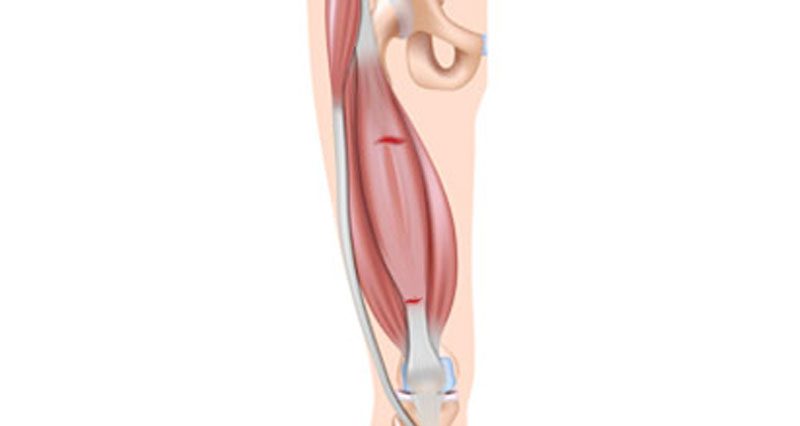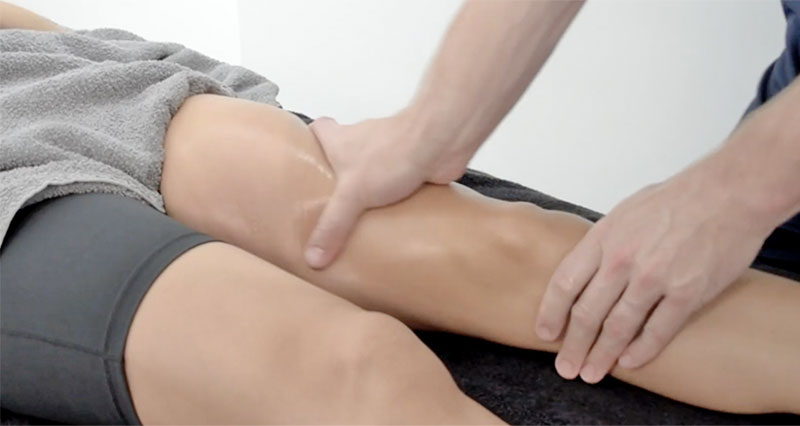A thigh muscle strain or quadriceps strain is a tear in one of the quadriceps muscles at the front of the thigh. It is a common injury in sprinting and jumping-related sports. Treatment consists of immediate first followed by a full step-by-step rehabilitation program.
Medically reviewed by Dr Chaminda Goonetilleke, 10th Jan. 2022.
Thigh muscle strain symptoms
If you have suffered a strained thigh muscle then symptoms typically include:
- A sudden sharp pain at the front of the thigh
- You may have some swelling depending on the type and severity of the injury
- Thigh strains are graded from 1 to 3 depending on how bad your injury is
- A grade 1 is mild and grade 3 involves a complete or near-complete tear of the muscle
How bad is my thigh strain?
Thigh strains are graded 1 to 3 depending on severity and how much of the muscle has torn.
Grade 1
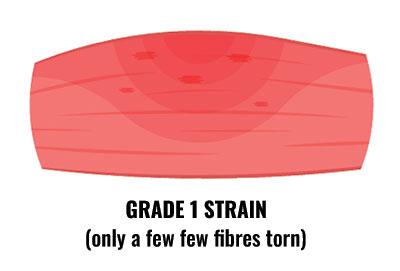
- If you have a grade 1 quad strain then it may not feel bad enough to stop training at the time.
- You might feel a twinge in the thigh, with a general feeling of tightness.
- Walking may cause mild discomfort and running might be difficult.
- You are unlikely to have swelling, but you may feel a lump in the muscle.
Grade 2
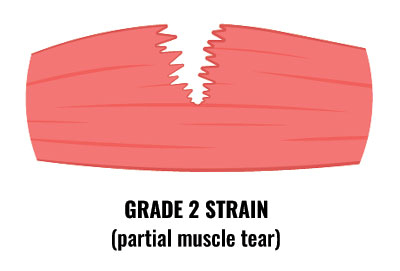
- Grade 2 symptoms are more severe than grade two.
- You may feel a sudden sharp pain when running, jumping or kicking and be unable to play on.
- Pain will make walking difficult and you will notice swelling or mild bruising.
- The pain would be felt when pressing into the muscle, particularly where it is torn.
- When diagnosing thigh strains your therapist will get you to straighten your leg whilst they resist it. Pain indicates injury to the muscle.
Grade 3
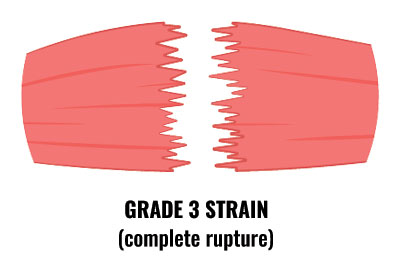
- Grade 3 symptoms consist of severe, sudden pain in the front of the thigh.
- The patient will be unable to walk without the aid of crutches.
- With grade 3 thigh strains, significant swelling can develop immediately. Bruising deveops within 24 hours.
- A static muscle contraction will be painful and is likely to produce a bulge in the muscle.
- The patient can expect to be out of competition for 6 to 12 weeks.
Thigh strain assessment & diagnosis
A professional therapist will do a full assessment in order to accurately diagnose your injury. This should include:
- Questions about your general health, previous injury as well as current injury.
- Your therapist will then perform a physical assessment of the injury.
- This includes observation and palpation (feeling the area),
range of motion tests and resisted muscle tests.
What is a thigh muscle strain?
The quadriceps muscles at the front of the thigh consist of the vastus lateralis, vastus medialis, vastus intermedius, and the rectus femoris.
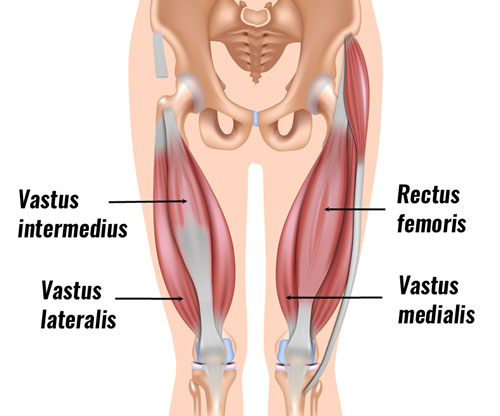
A thigh muscle strain is a tear in the muscle and ranges in severity, from a very small tear to a complete rupture. Quadriceps muscle strains usually occur during activities such as sprinting, jumping or kicking. Not warming up properly is a often a factor.
Any of the quadriceps muscles can tear, but probably the most common is the rectus femoris. This is because it is the only one of the four muscles which cross both the hip and knee joints. Therefore this makes it more susceptible to injury. Thigh muscle strains usually occur at one of two locations in the muscle:
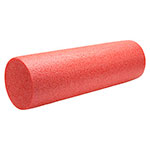
Foam Rollers
Musculotendinous junction (MTJ) strains
This is where the muscle joins/becomes a tendon, which then attaches to the bone. This is most likely to occur just above the knee.
Bulls-eye lesion
This is a tear higher up your thigh, in the belly of the thigh muscle, and nearer the hip. This is commonly known as a ‘bulls-eye’ lesion. Other injuries to the thigh muscles include:
- Injury to the rectus femoris tendon will be felt at the origin of the muscle at the hip. This can be a tendon strain (tear), or can also be an overuse/inflammation type injury.
- Injuries that occur following a direct impact on the muscle, such as being hit by a ball or other hard object, are more likely to be contusions and should be treated slightly differently.
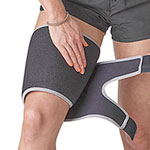
Buy Thigh Supports
Thigh strain treatment
Treatment consists of immedate first aid followed by a full thigh strain rehabilitation program.
What can the athlete do?
Apply the cold therapy PRICE principles of protection, rest, ice, compression, and elevation. Protect your injured muscle by wearing a thigh support or compression bandage. Compression helps reduce swelling and protects the area.
Rest from all sports activities in the early stages whilst your muscle begins to heal. If you continue to train on an injured muscle, you prevent it from healing properly. Elevate your injured leg to help swelling and tissue fluids flow away from the site of the muscles strain.
Apply a cold therapy and compression wrap as soon as possible after injury and again every two hours for 10 minutes over the first 24 to 72 hours. Reduce frequency as your symptoms improve. Cold therapy and compression helps stop swelling and hopefully limit the extent of the injury.
Later after the acute phase has passed begin a full thigh strain rehabilitation program. Avoid stretching in the early stages of rehabilitation in order to allow it time to heal.
What can a professional therapist do?
A professional therapist can make an accurate diagnosis and advise on a detailed rehabilitation program. This is important so you know exactly what your injury is. They may also use electrotherapy such as ultrasound to aid the healing process. Later, as you progress they are likely to use sports massage techniques.
Sports massage for the thigh muscles is beneficial after the initial acute stage has passed. This is because it helps to increase blood flow to the muscles and relaxes them, which aids the healing process. Also, massage helps improve flexibility and loosens any tight knots or lumps following injury. It is also thought to realign scar tissue and improve tissue elasticity. However, if you massage too early, or too deep too soon then you are likely to further damage the muscle.

Foam Rollers
Thigh strain exercises
After the initial acute stage has passed, begin a full step-by-step rehabilitation program which inclues stretching, strengthening, activation and functional exercises.
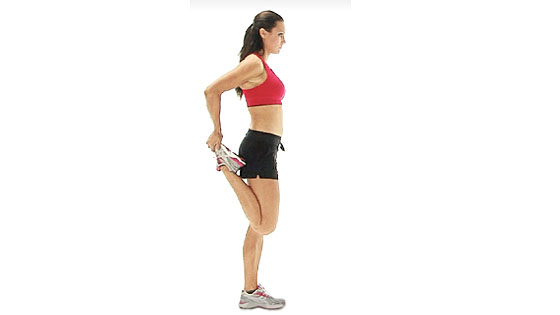
Stretching: Avoid quadriceps stretching exercises immediately after injury and throughout the acute phase. Stretching should always be done pain free so wait until you can easily stretch the muscle withought pain or discomfort. However, you should continue to stretch all other parts of the body.
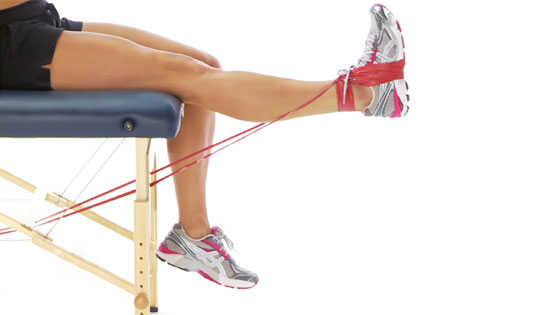
Strengthening: Our thigh strain rehab program gradually increases the load through your muscle. Begin as early as day 5 after injury with isometric strengthening exercises as long as they are pain free. Later progress to dynamic resistance band exercises before progressing to sports-specific running and sprint drills.
Eventually, more sports-specific or functional strengthening exercises are done involving sprinting, change of direction, and plyometric or hopping-type exercises. We also include activation exercises to keep the muscles aroung the hip firing and in good condition. Learn more about our step-by-step thigh strain rehabilitation program written by elite level professional football physiotherapist Paul Tanner.
References
- Hughes C, Hasselman CT, Best TM, et al. Incomplete, intrasubstance strain injuries of the rectus femoris muscle. Am J Sports Med 1995;23:500-6
- Gyftopoulos S, Rosenberg ZS, Schweitzer ME et al. Normal anatomy and strains of the deep musculotendinous junction of the proximal rectus femoris: MRI features. Am J Roentgenol 2008;190(3): W182-6
